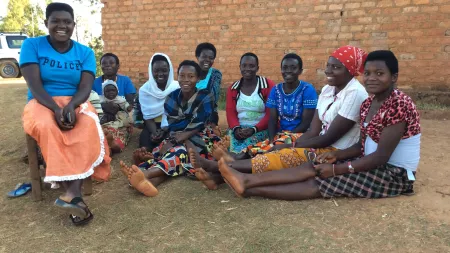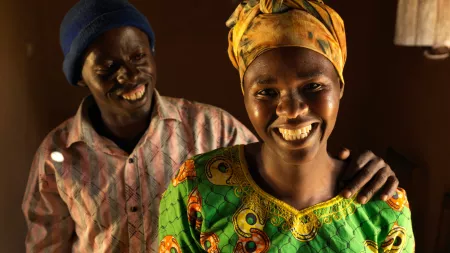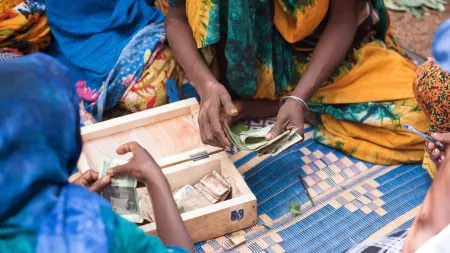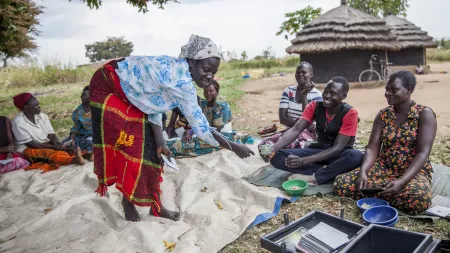“There is no specific role for a man, there is no specific role for a woman, and there is no role for children. We all divide the work and we do it willingly. We help each other. It has created cooperation. I am empowered because after the training, I can now express myself. I speak freely and my husband and children listen to me. I can even go to [savings group] meetings and chair the meetings. I never used to talk in public, but after the trainings, I managed to speak for myself,” says Aidah Tushemerire 55, Subsistence Farmer and Decor Business Owner and CARE Digital Sub-Wallet Participant.
Aidah’s words show what gender equality means for her in her life. It all started with joining a community savings group. Our Village Savings and Loan Associations (VSLAs) are a proven way of supporting women to develop financial stability, increase resilience to shocks, and invest in income-generating activities. But at CARE, savings groups are about more than just money. They are a platform for building skills and confidence, improving power relations, and transforming women’s role in society.
We analyzed studies from four VSLA projects in East and Central Africa in Burundi, Ethiopia, Rwanda, and Uganda – to look at how savings groups have contributed to increased gender equality. This showed combining savings groups with approaches intentionally addressing the underlying causes of inequality amplifies return on investment and improves outcomes across participants’ lives.

What did we accomplish?
- Couples making decisions as equals: In Uganda, couples who participated in household counseling discussions about gender equality through the Digital Sub-Wallets project reported an increase in financial decision-making in their households and 81% saw positive changes in their spouse's behavior.
- Women were safer: The Indashyikirwa project in Rwanda contributed to a 55% reduction in the odds of women experiencing intimate partner violence and increased their odds of having cash income.
- Women had more access to markets and capital: In the Livelihoods for Resilience program, which worked with more than 100,000 women in Ethiopia, 48% of the microfinance account holders were women and all accessed loans facilitated by the project. 300,000 USD in cash transfers were distributed to households and 89% of women reported having a role in decision-making about how to use the cash investments.
- Families were more resilient: Because women had more freedom to work and participate in household decisions, couples who participated in the Indashyikirwa program improved their food insecurity by both contributing to food costs.
- Men’s perceptions of gender norms shifted: By the end of the Win-Win program in Burundi, male participants were more likely to reject gender-based violence (GBV) in their homes and communities and were increasingly supportive of women’s empowerment.
- Higher returns on investment (ROI): The 5:1 ROI of the Win-Win program showed that prioritizing gender in programming can create higher returns than programs that take a light approach to gender integration.

How did we get there?
- Focus on women’s skills and confidence first: Prioritizing women’s self-esteem and supporting them in growing their aspirations to change their world is the basis of all of VSLA initiatives.
- Harmful social norms must be challenged: To support women’s ambitions, whether those be in social, economic, or political realms, projects worked to dismantle harmful norms and inequalities that discourage or limit their mobility and freedom.
- Gender dialogue is key: Engaging couples in dialogue together about gender equality has proven to have positive results in shifting household responsibility and power sharing.
- Mitigating and addressing GBV risks is crucial: Increasing women’s income has the potential to lead to negative backlash, including increased experiences of GBV, so projects took this into account from the outset and integrated mitigation measures.
- We have to include men and boys: To create sustainable change in gender equality, all of society needs to be involved. Engaging men and boys helps to alter social norms and cement women’s equal place and opportunity in societies.

What did we learn?
- Staff transformation: Creating space for staff to reflect on gender norms and power relations is important.
- Focus on group solidarity first: VSLA groups need time to establish themselves to create trust and for relationships between participants and key reference groups to become clear.
- Choose approaches based on the local context: Using gender analyses helps to understand power dynamics, gender, and social norms and to select and adapt approaches to local contexts. This also creates space for communities to determine their priorities.
- Include all three components of the Gender Equality Framework in the design: Including activites to build agency, change relations, and transform structures creates programs that are more likely to address the root causes of gender inequality.
Want to learn more?
Gender Equality through Savings Groups: Gender Integration and Gender Transformative Approaches in VSLA Programming
